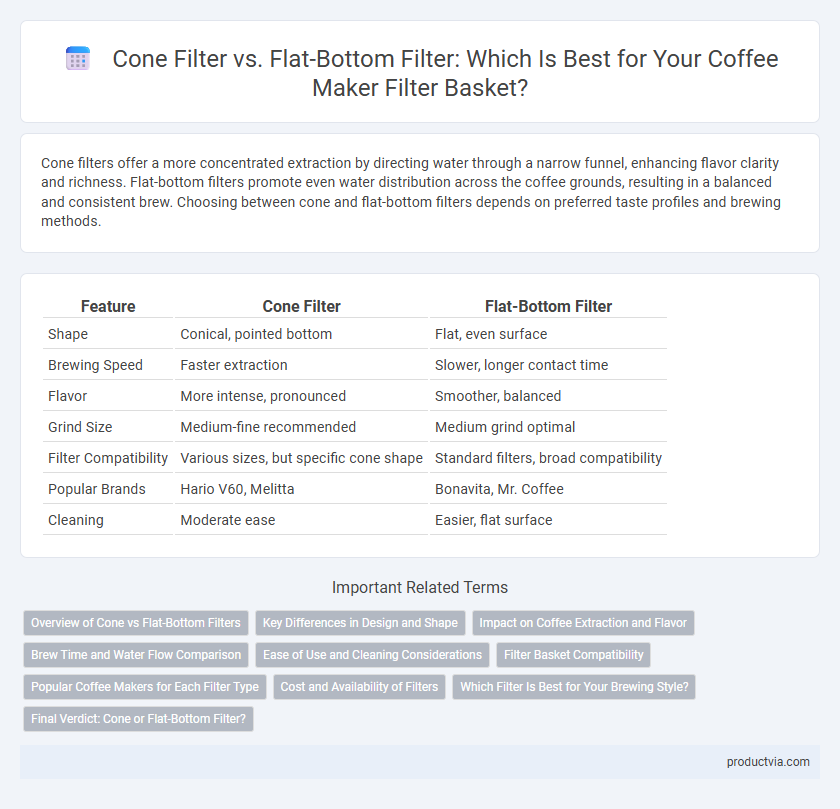Cone filters offer a more concentrated extraction by directing water through a narrow funnel, enhancing flavor clarity and richness. Flat-bottom filters promote even water distribution across the coffee grounds, resulting in a balanced and consistent brew. Choosing between cone and flat-bottom filters depends on preferred taste profiles and brewing methods.
Table of Comparison
| Feature | Cone Filter | Flat-Bottom Filter |
|---|---|---|
| Shape | Conical, pointed bottom | Flat, even surface |
| Brewing Speed | Faster extraction | Slower, longer contact time |
| Flavor | More intense, pronounced | Smoother, balanced |
| Grind Size | Medium-fine recommended | Medium grind optimal |
| Filter Compatibility | Various sizes, but specific cone shape | Standard filters, broad compatibility |
| Popular Brands | Hario V60, Melitta | Bonavita, Mr. Coffee |
| Cleaning | Moderate ease | Easier, flat surface |
Overview of Cone vs Flat-Bottom Filters
Cone filters create a funnel shape that directs water to a central point, promoting a faster brew and often resulting in a richer, more concentrated coffee flavor. Flat-bottom filters provide a larger surface area for coffee grounds, allowing for even extraction and producing a balanced and consistent taste. Choosing between cone and flat-bottom filters depends on personal preference for strength, flavor clarity, and brew time.
Key Differences in Design and Shape
Cone filters feature a conical shape that directs water flow through coffee grounds at a single focal point, enhancing extraction and flavor concentration. Flat-bottom filters, with their wider, evenly distributed flat base, promote uniform water dispersion and extraction across the coffee bed, resulting in a balanced brew. The design differences affect grind size preference, with cone filters favoring medium to medium-fine grounds, while flat-bottom filters accommodate medium to coarse grounds for optimal performance.
Impact on Coffee Extraction and Flavor
Cone filters concentrate coffee grounds at the center, promoting longer water contact time and enhancing extraction, which results in a richer, more intense coffee flavor. Flat-bottom filters distribute grounds more evenly, allowing faster water flow and a cleaner, brighter taste with less bitterness. The choice between cone and flat-bottom filters directly affects the balance of extraction, aroma, and overall cup complexity.
Brew Time and Water Flow Comparison
Cone filters enhance water flow by directing liquid toward a single point, resulting in a longer brew time that allows more flavor extraction. Flat-bottom filters promote even water distribution across grounds, leading to a shorter brew time and a more balanced extraction. Optimal brew time and water flow depend on grind size and filter shape, with cone filters favoring medium-fine grounds and flat-bottom filters working best with medium grinds.
Ease of Use and Cleaning Considerations
Cone filters in coffee makers typically allow water to flow more evenly through the grounds, enhancing extraction while being slightly easier to position in the basket. Flat-bottom filters offer uniform brewing and are generally simpler to clean because their shape prevents grounds from getting trapped as easily. Both filter types require regular rinsing, but flat-bottom filters tend to reduce residue buildup, minimizing maintenance efforts.
Filter Basket Compatibility
Cone filters and flat-bottom filters differ primarily in their compatibility with various filter baskets; cone filters are designed for baskets with a conical shape that provides even water flow and optimal extraction, while flat-bottom filters require flat-bottom baskets to ensure proper fit and consistent brew saturation. Coffee makers often specify the compatible filter basket type to maximize performance, as using an incompatible filter shape can lead to uneven brewing and clogging. Understanding the match between filter shape and basket design is crucial for maintaining consistent flavor profiles and efficient coffee extraction.
Popular Coffee Makers for Each Filter Type
Popular coffee makers designed for cone filters include the Chemex and Hario V60, both praised for enhanced extraction and richer flavor profiles. Flat-bottom filter coffee makers like the Bonavita Connoisseur and Breville Precision Brewer deliver even saturation and balanced taste due to their broad extraction surface. Choosing between cone and flat-bottom filters impacts brewing dynamics and the compatibility of popular dripper models for optimal coffee experience.
Cost and Availability of Filters
Cone filters generally cost more but are widely available in various sizes and brands, providing flexibility for different cone filter coffee makers. Flat-bottom filters tend to be more affordable and are often sold in larger bulk packs, making them cost-effective for frequent brewers. Both filter types are commonly found in supermarkets and online, but cone filters may have a slightly higher price point due to their shape and compatibility with premium coffee machines.
Which Filter Is Best for Your Brewing Style?
Cone filters concentrate coffee grounds at the center, allowing water to flow more evenly and produce a richer, more intense flavor ideal for those preferring bold, full-bodied coffee. Flat-bottom filters distribute grounds evenly across the basket, promoting consistent extraction and balanced taste perfect for brewing medium to light roasts with smooth, nuanced flavors. Choosing between cone and flat-bottom filters depends on your preferred strength and flavor profile, with cone filters enhancing boldness and flat-bottom filters emphasizing clarity and uniformity.
Final Verdict: Cone or Flat-Bottom Filter?
Cone filters create a concentrated extraction with richer flavor due to their shape directing water through coffee grounds more evenly. Flat-bottom filters promote balanced extraction and a cleaner cup by allowing water to flow through a larger surface area. The final verdict depends on personal taste preference: choose cone filters for bold, intense brews and flat-bottom filters for smoother, more consistent coffee.
Cone filter vs Flat-bottom filter for filter basket Infographic

 productvia.com
productvia.com